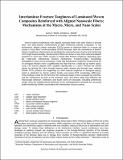Interlaminar Fracture Toughness of Laminated Woven Composites Reinforced with Aligned Nanoscale Fibers: Mechanisms at the Macro, Micro, and Nano Scales
Author(s)
Wicks, Sunny S.; Wardle, Brian L.
DownloadWardle_Interlaminar fracture.pdf (856.0Kb)
OPEN_ACCESS_POLICY
Open Access Policy
Creative Commons Attribution-Noncommercial-Share Alike
Terms of use
Metadata
Show full item recordAbstract
Several hybrid architectures with aligned nanoscale fibers have been shown to provide inter- and intra-laminar reinforcement of fiber reinforced polymer composites. In one architecture, aligned carbon nanotubes (CNTs) grown on advanced fibers in a woven ply creates a ‘fuzzy fiber’ reinforced plastic (FFRP) laminate. Here the mechanisms of Mode I fracture toughness enhancement are elucidated by varying the type of epoxy and reinforcing CNT length experimentally. Reinforcement effects are shown to vary from reduced initiation toughness to more than 100% increase in steady-state fracture toughness, depending upon the multi-scale interlaminar fracture mechanisms. Fracture-surface morphology investigations using several techniques reveal that interlaminar toughness enhancement for an aerospace infusion resin is significantly less than that for a hand lay-up marine epoxy. Long (~20 micron) aligned CNTs toughens significantly (> 1 kJ/m[superscript 2] increase for marine epoxy) by driving the crack through tortuous paths around and through tows, whereas shorter CNTs produce less toughening (or even reduced toughness in aerospace epoxy), which is attributed to shorter pullout lengths and grown-CNT morphology differences. These findings reveal for the first time the multiscale nature of the composite ply interface, and the mechanisms at work at the chemical, nano, and micro scales that influence the macroscopic behavior. Extensions and future work are discussed, including preliminary results using the multifunctional attributes of the nanoengineered composite for structural health monitoring (SHM) concomitant with interlaminar fracture testing.
Date issued
2013-04Department
Massachusetts Institute of Technology. Department of Aeronautics and AstronauticsJournal
Proceedings of the 54th AIAA/ASME/ASCE/AHS/ASC Structures, Structural Dynamics, and Materials Conference
Publisher
American Institute of Aeronautics and Astronautics
Citation
Wicks, Sunny S., and Brian L. Wardle. “Interlaminar Fracture Toughness of Laminated Woven Composites Reinforced with Aligned Nanoscale Fibers: Mechanisms at the Macro, Micro, and Nano Scales.” 54th AIAA/ASME/ASCE/AHS/ASC Structures, Structural Dynamics, and Materials Conference (April 5, 2013).
Version: Author's final manuscript
ISBN
978-1-62410-223-3